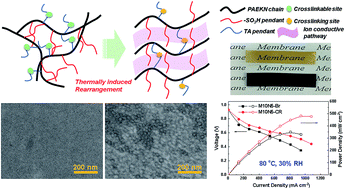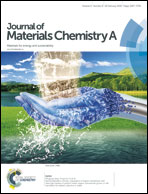A thermally crosslinked multiblock sulfonated poly(arylene ether ketone nitrile) copolymer with a 1,2,3-triazole pendant for proton conducting membranes†
Abstract
A novel concept for the molecular design of a proton conducting membrane is proposed; this concept simultaneously implements strategies involving multiblock, thermally induced rearrangement and acid–base interaction. The complete synthesis involves oligomeric polycondensation, followed by the introduction of a 1,2,3-triazole side-chain via a click reaction, sulfonation and intermolecular dimerization, to generate a mechanically robust and chemically stable polymer membrane. The results of characterization demonstrate significant microphase separation of the crosslinked membrane due to morphological transformation, and that the presence of a large amount of weak-base pendants contributes to the enhancement of ion conductivity over the entire relative humidity range (30–95%). Moreover, it also generates power outputs as high as 1.07, 0.87 and 0.48 W cm−2 at 80 °C under 95%, 70% and 30% relative humidity conditions, respectively, which significantly improve the fuel cell performance by 34–40%, compared to the virgin membrane. In general, the results of this study suggest new synthetic pathways for high-performance ion-exchange membranes.



 Please wait while we load your content...
Please wait while we load your content...